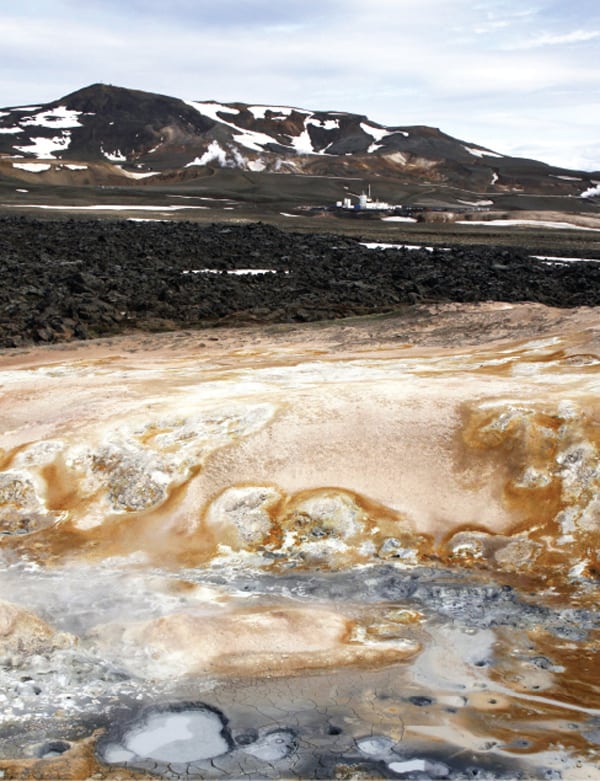Geologists Tap Magma for Energy Production
Geologists drilling an exploratory well in Iceland’s Krafla volcano in search of supercritical geothermal resources in 2009 unexpectedly uncovered a new way to harness energy from deep within Earth’s crust. It involves accessing shallow bodies of molten rock, which the geologists say could likely be found elsewhere in Iceland and around the world, wherever young volcanic rocks occur.
Efforts to find supercritical resources took a wayward turn for the researchers from Icelandic power firms, American universities, and research bodies, including the U.S. Geological Survey, when magma chanced to fill 30 feet of the 6,900-foot-deep open borehole, forcing them to terminate drilling (Figure 3). The hole was instead completed as a production well.
 |
| 3. A hot prospect. A project that entailed drilling a 6,900-foot-deep geothermal well to test whether geothermal fluids at supercritical pressures and temperatures could be exploited as a source of power in Iceland’s Krafla volcano came to a halt in 2009 after 1,652F magma intruded the open borehole. Researchers terminated drilling and finished the project as a production well—harnessing magma energy. The drilling rig is viewed in this picture across a basalt flow from the 1974-85 eruption. The Leirhnjúkur hot spring area is in the foreground. Courtesy: W. Elders, University of California, Riverside |
“To the best of our knowledge, only one previous instance of magma flowing into a geothermal well while drilling has been documented,” said Wilfred Elders, a professor emeritus of geology in the Department of Earth Sciences at the University of California, Riverside, who led the research team. “We were drilling a well that was designed to search for very deep—[15,000 feet]—geothermal resources in the volcano. While the magma flow interrupted our project, it gave us a unique opportunity to study the magma and test a very hot geothermal system as an energy source.”
Elders, who published a research paper chronicling and analyzing the magma intrusion in the March issue of Geology (“Origin of a rhyolite that intruded a geothermal well while drilling at the Krafla volcano, Iceland”), said the finding was significant, mainly because the economics of power generation “from such geothermal steam improves the higher its temperature and pressure.” And it is technically feasible, too, he suggested: “As you drill deeper into a hot zone the temperature and pressure rise, so it should be possible to reach an environment where a denser fluid with very high heat content, but also with unusually low viscosity occurs, so-called ‘supercritical water.’ Although such supercritical water is used in large coal-fired electric power plants, no one had tried to use supercritical water that should occur naturally in the deeper zones of geothermal areas.”
Elders and colleagues reported in the journal article that the magma they encountered is a rhyolite (a volcanic rock containing 65% to 70% silica)—even though all other volcanoes in Iceland are basaltic (containing 45% to 50% silica). Geothermal systems’ water reacts with and alters the composition of the rocks, a process termed “hydrothermal alteration,” Elders explained. “Our research shows that the rhyolite formed when a mantle-derived basaltic magma encountered hydrothermally altered basalt, and partially melted and assimilated that rock.”
The high-pressure dry steam flowing to the surface from a depth shallower than the magma was heated to 400C (750F), the researchers found. That steam could have a generating capacity of about 25 MW—much more than the 5 MW to 8 MW that can be harvested from a 300C wet stream, Elders estimated.
The Krafla caldera project, which originated as a way to test whether geothermal fluids at supercritical pressures and temperatures could be exploited as a source of power, was part of the Iceland Deep Drilling Project, an industry-government consortium.
Along with the University of California (UC), Riverside, the project was conducted by researchers from Iceland’s HS Orka hf (HS Power Co.), and Icelandic firms GeoSurvey and Landsvirkjun Power. Also involved were UC Davis, Stanford University, New Mexico Institute of Mining and Technology, and the University of Oregon, Eugene.
—Sonal Patel is POWER’s senior writer.